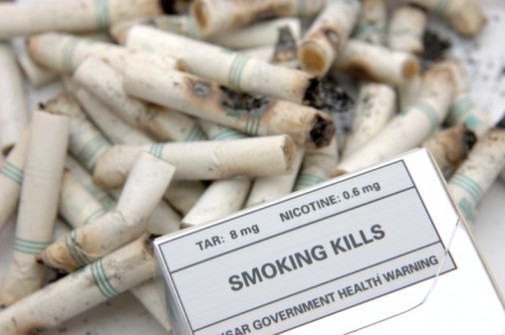Smoking rates decline with graphic warning labels

More than a decade ago, Canada was the first country to introduce graphic health warnings on the outside of cigarette packages, which has proven effective at reducing the country’s smoking rate. A new study says that if the United States tries a similar approach, we, too, could have considerably lower rates of smoking.
The research, published in November online in the journal Tobacco Control, found that Canadian labels on cigarettes resulted in a 2.9 to 4.7 percentage point decrease in smoking rates. If the United States had implemented similar labeling requirements, researchers estimate that this would have translated to 5.3 to 8.6 million fewer U.S. smokers in 2013.
By using statistical methods, researchers compared smoking rates in the United States and Canada over a period of nine years before and after Canada introduced graphic warning labels. Also factored into the analysis was the cost of cigarettes.
In doing its own research, the Food and Drug Administration (FDA) had estimated only a 0.088 percentage point decrease in smoking rates after Canada mandated graphic warning labels. However, the November study revealed that the FDA’s so-called regulatory impact analysis used to gauge the effectiveness of the warning labels was inaccurate.
Lead author of the study, Jidong Huang, said in a statement when he and his team corrected the FDA’s flaws in methodology and factored in the purchase price smokers paid, they found that graphic warning labels lower cigarette smoking at much higher rates.
In 2009, the Family Smoking Prevention and Tobacco Control Act gave the Food and Drug Administration (FDA) the authority to require prominent warning labels for cigarettes and smokeless tobacco products. However, the tobacco industry challenged this requirement and a U.S. Court of Appeals ruled that the FDA lacked enough evidence to prove that graphic warning image would actually reduce the smoking rate.
Other studies have shown that these labels affect behavior in many ways, however, they have not indicated whether this labeling approach reduces overall smoking rates.
“As a physician who has seen nicotine addiction lead to strokes, heart attacks and cancers in our patients, I advise that we all support graphic labels on tobacco products,” says Dr. Prentiss Taylor, an internal medicine/preventive medicine physician with Advocate Medical Group.
“Physicians can ask patients to pull out their pack of cigarettes and use future graphic labeling as a springboard for persuasion of tobacco users to call free quit hotline resources. Such labels increase knowledge of the harms of tobacco products, motivate smokers to quit and decrease relapse rates among smokers who have quit,” Dr. Taylor adds.
Related Posts
Comments
About the Author
health enews staff is a group of experienced writers from our Advocate Health Care and Aurora Health Care sites, which also includes freelance or intern writers.

















